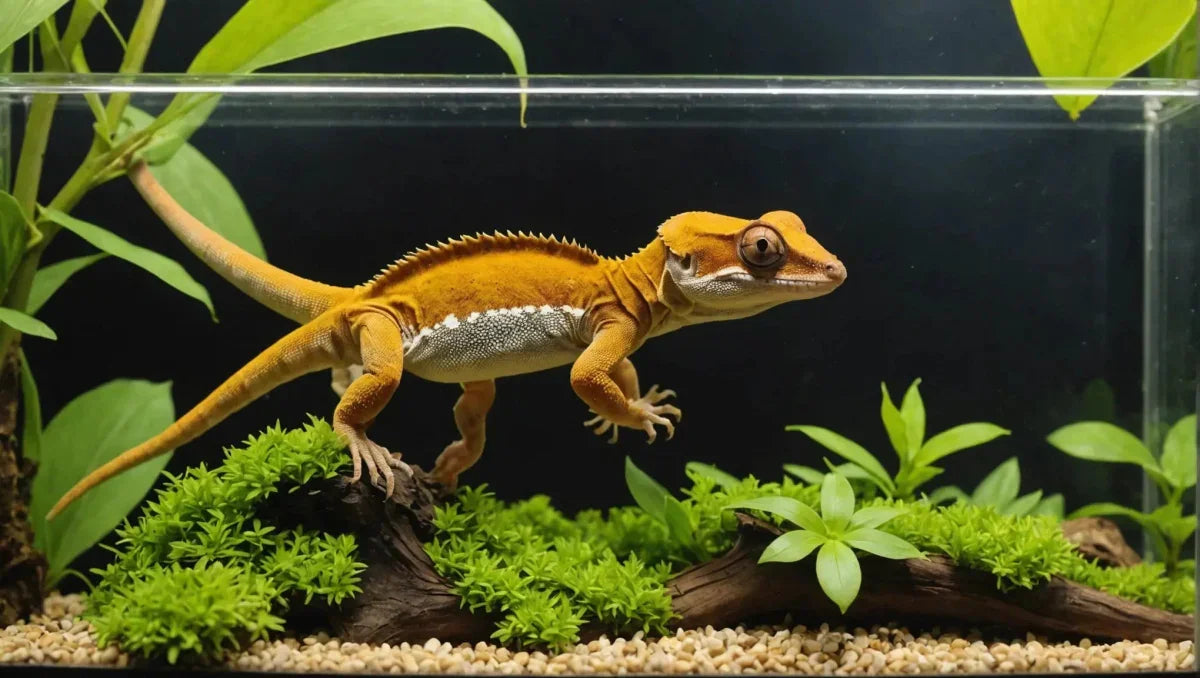Creating a Bioactive Habitat for Crested Geckos

Creating a bioactive habitat for crested geckos is a rewarding and enriching endeavor for both the keeper and the gecko. Incorporating live plants, microfauna, and a carefully balanced ecosystem, a bioactive vivarium closely mimics the natural environment of these fascinating creatures. This guide will explore the essential elements of constructing and maintaining a thriving crested gecko vivarium, from selecting the right plants to establishing a sustainable ecosystem. By following these steps, you can provide your crested gecko with a stimulating and dynamic habitat while minimizing the need for artificial maintenance. Whether you're a beginner or an experienced reptile enthusiast, this comprehensive approach to bioactive vivarium design will help you create a healthy, low-maintenance, and visually stunning home for your crested gecko.
Setting Up the Bioactive Crested Gecko Vivarium
Selecting the Right Enclosure
When setting up a bioactive crested gecko vivarium, it's crucial to select the right enclosure. A vertical terrarium is recommended as it provides ample space for the gecko to climb and explore. Ensure the enclosure has secure mesh lids to maintain proper ventilation and humidity levels. Consider the size of the enclosure; a single adult crested gecko requires a minimum of 20 gallons, but larger is always better to provide more space for activities and environmental enrichment.
Choosing the Ideal Substrate
The choice of substrate is vital for the health and well-being of your crested gecko. A bioactive substrate such as a mix of organic soil, sphagnum moss, and leaf litter helps maintain the vivarium's humidity and aids in the growth of beneficial microorganisms. Additionally, the substrate should promote burrowing behavior, as crested geckos enjoy digging and may benefit from having a substrate deep enough to engage in this natural behavior.
Selecting Suitable Live Plants
Live plants not only enhance the aesthetic appeal of the vivarium but also contribute to its ecosystem. Opt for non-toxic plants such as Pothos, Snake Plant, and Bromeliads, which thrive in the warm, humid environment of a crested gecko vivarium. Ensure the selected plants are safe for the gecko in case they decide to nibble on the leaves. Moreover, providing a variety of plant heights and textures can offer hiding spots and climbing opportunities for the gecko, adding to its overall well-being and environmental enrichment.
Incorporating a Clean-Up Crew
Introducing a cleanup crew comprising isopods and springtails is essential for maintaining a healthy vivarium. These organisms aid in breaking down waste, decaying plant matter, and uneaten food, preventing the accumulation of harmful bacteria and odors. It's important to establish a balanced population of these organisms to ensure effective waste management within the vivarium.
Maintaining the Ecosystem Balance
Regular maintenance is key to upholding the vivarium's ecosystem balance. Monitor humidity levels, perform spot-cleaning as needed, and ensure the live plants receive adequate light and water to create a thriving and sustainable environment for your crested gecko. Additionally, consider the introduction of beneficial microfauna, such as springtails, to assist in maintaining a healthy substrate and to support the overall ecosystem within the vivarium.
Feeding and Care in a Bioactive Crested Gecko Vivarium
Dietary Considerations for Bioactive Environments
In a bioactive crested gecko vivarium, dietary considerations play a crucial role in maintaining the health and vitality of these fascinating creatures. The diet should consist of a variety of live insects, such as crickets, roaches, and phoenix worms, supplemented with a powdered diet specifically formulated for crested geckos. Incorporating a diverse range of prey items ensures that the geckos receive essential nutrients and helps simulate their natural feeding behaviors. Additionally, it’s essential to provide calcium and vitamin supplements to ensure their nutritional needs are met. This can be achieved by dusting the live insects with a calcium and vitamin powder before feeding them to the geckos, ensuring they receive the necessary nutrients for their growth and development.
Monitoring Health and Behavior
Regular monitoring of the crested geckos' health and behavior is essential for early detection of potential issues. Observing their eating habits, activity levels, and overall appearance can provide valuable insights into their well-being. Additionally, maintaining optimal environmental conditions within the vivarium, including temperature, humidity, and lighting, contributes to the geckos' overall health. It’s crucial to ensure that the temperature in the vivarium remains within the range of 72-78°F (22-25°C) during the day and doesn’t drop below 65°F (18°C) at night. Humidity levels should be maintained at around 60-80% to mimic their natural habitat. Providing adequate UVB lighting is also essential for their calcium metabolism and overall well-being.
Behavioral Enrichment and Habitat Design
In a bioactive vivarium, it’s important to incorporate elements that cater to the geckos’ natural behaviors and provide mental stimulation. This can be achieved by including live plants, branches, and natural hiding spots within the vivarium. The presence of live plants not only enhances the aesthetic appeal of the enclosure but also helps maintain humidity levels and provides hiding places for the geckos. Additionally, creating a varied terrain with different levels and textures can encourage natural behaviors, such as climbing and exploration. It’s essential to ensure that all elements within the vivarium are non-toxic and safe for the geckos. Regular maintenance of the bioactive setup, including spot-cleaning, maintaining plant health, and monitoring for any potential hazards, is crucial for the well-being of the crested geckos.
Maintaining a Healthy Bioactive Crested Gecko Vivarium
Regulating Temperature and Humidity
Creating an optimal environment for your crested gecko involves regulating temperature and humidity levels within the vivarium. It's essential to maintain a consistent temperature range of 72-78°F (22-25.5°C) during the day and slightly cooler temperatures at night. To achieve this, consider using under-tank heating pads or ceramic heat emitters for warmth. Additionally, a reliable misting system can help regulate humidity levels, which should ideally be maintained between 60-80%. Regular monitoring with accurate hygrometers is crucial to ensure the environment remains suitable for your gecko's well-being.
Managing Waste and Cleaning
Proper waste management and regular cleaning practices are fundamental for the thriving of a bioactive vivarium. When removing waste, such as feces and uneaten food, it's important to do so carefully to avoid disrupting the delicate ecosystem. Finding a balance between waste removal and preserving beneficial microorganisms is key. Consider spot-cleaning to remove visible waste while leaving some behind to sustain the bioactive substrate. Utilize bioactive custodians like springtails and isopods to aid in breaking down organic matter, thus maintaining a healthy environment.
Preventing and Handling Common Issues
Proactivity is essential in preventing common issues in a bioactive crested gecko vivarium, such as mold growth, pest infestations, or imbalances in the microclimate. To prevent mold, ensure proper ventilation and avoid over-saturating the substrate with water. Regularly inspect and quarantine new plants or decor to prevent pest infestations. In the event of imbalances, adjusting the misting frequency or introducing additional ventilation can often help restore equilibrium. Vigilance and consistent monitoring are crucial to promptly address any issues that may arise. Remember, maintaining a healthy bioactive vivarium is an ongoing process that requires attention and dedication to ensure the well-being of your crested gecko.
Creating a Stimulating Environment
In addition to maintaining the physical aspects of the vivarium, it's important to provide a stimulating environment for your crested gecko. Incorporate a variety of natural decor, such as live plants, branches, and hiding spots, to encourage natural behaviors and mental stimulation. Regularly rearrange or add new decor to prevent boredom and promote an enriching habitat for your gecko. Additionally, consider a diverse diet and regular handling to support your gecko's overall health and well-being, both physically and mentally.
Enhancing Your Crested Gecko's Environment
Adding Enrichment and Climbing Opportunities
Crested geckos are arboreal creatures and thrive in environments that simulate their natural habitat. This can be achieved by incorporating a variety of branches, vines, and ledges within their enclosure, allowing them to explore and exercise their natural climbing instincts.
Creating Hiding and Sleeping Spaces
Creating hiding and sleeping spaces is essential for your gecko's mental and physical health. This can be accomplished by strategically placing plants, cork bark, or commercially available hides throughout the enclosure. These spaces offer your gecko a sense of security and privacy, crucial for reducing stress and promoting healthy sleeping patterns.
Ensuring Safety and Security
Ensuring safety and security within the enclosure is paramount. This involves carefully examining the enclosure for any potential hazards, such as sharp edges or gaps that could pose a risk to your gecko. Additionally, double-checking the stability of climbing structures and regularly inspecting the enclosure for wear and tear can help prevent accidents and injuries.
To further enrich your crested gecko's environment, consider the introduction of live plants. Live plants not only add a natural aesthetic to the enclosure but also contribute to the overall environmental quality. They help maintain humidity levels, provide additional climbing surfaces, and offer hiding spots for your gecko. However, it's important to select non-toxic plant species and ensure that they are suitable for the gecko's habitat.
Another aspect to consider is the lighting and heating within the enclosure. Adequate lighting and a suitable temperature gradient are essential for the well-being of your crested gecko. UVB lighting is beneficial for their overall health, aiding in calcium metabolism and preventing metabolic bone disease. Additionally, a proper temperature gradient allows the gecko to regulate its body temperature, supporting essential physiological functions.
It's also advisable to incorporate varied textures and substrates within the enclosure. This can include a mix of natural substrates, such as coconut fiber or sphagnum moss, which not only assist in maintaining humidity but also provide a comfortable and natural surface for your gecko to explore and interact with.
Regular maintenance of the enclosure is crucial for sustaining an optimal environment for your crested gecko. This includes periodic cleaning, substrate replacement, and ensuring that all equipment, such as heating elements and humidity gauges, are functioning correctly.
By implementing these additional considerations, you can create a dynamic and enriching environment that closely mirrors the natural habitat of crested geckos, ultimately promoting their physical health, natural behaviors, and overall well-being.
Creating a bioactive habitat for a crested gecko vivarium is a rewarding and beneficial endeavor for both the gecko and the keeper. By incorporating live plants, clean-up crew, and natural substrate, we can mimic the gecko's natural environment, promoting their well-being and overall health. Additionally, the self-sustaining nature of a bioactive vivarium reduces the need for frequent cleaning and maintenance, allowing for a more natural and low-stress environment for the gecko. Overall, the bioactive approach offers a holistic and enriching experience for both the crested gecko and its owner.





